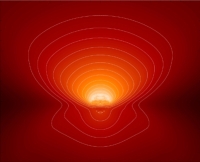
|
Almost all our information about astrophysical objects have been
obtained by analyzing their radiation.
Therefore, radiative transfer modeling of spectra and images is a
standard technique of astrophysical research. Moreover, radiation transport is an important physical process to transport energy and momentum, often controlling the energy balance of the object, or altering its appearance by radiation pressure. Given those two major applications of radiative transfer, it could be expected that RT modeling is a well-advanced and elaborated astrophysical tool being established for many years already. On the contrary, the solution of radiative transfer problems is still one of the outstanding challenges in computational astrophysics due to its high dimensionality and the underlying integro-differential transport equation. The increasing resolution of images and the need to include more sophisticated radiative transfer into hydrodynamical codes imposes further need of the astrophysical community for fast and reliable radiative transfer solvers. Due to the local and temporal proximity of the conference Cosmic-Dust - Near and Far, the workshop will have a focus on continuum radiative transfer in all its technical aspects. The meeting also is meant as a friendly exchange of information, not as a competition of codes, especially given the vast amount of data needing modeling and the relatively small number of active coders. |  |
Solution and Simulation Methods for the Continuum Radiative Transfer equations
Monte Carlo, ray-tracing, moments, finite differences, finite elements, etc. under the aspects of resolution, error control, acceleration, boundary conditions, etc.
Dust Emission
Thermal equilibrium, thermal non-equilibrium, heating mechanisms, sublimation border, opacities, approximations
Continuum Radiative Transfer and other codes
(Magneto-)Hydrodynamical simulations like Smoothed Particle Hydrodynamics, Adaptive Mesh Refinement, multi-fluid codes dealing with neutral and charged gas, chemical network codes, ...
Spectral Energy Distribution and image modeling
Interferometric data, multi-instrument data, fitting algorithms and ambiguities, inverse Continuum Radiative Transfer methods
Future
Distributed codes, community developed codes (e.g., open software, ASD, ...), time-dependent codes (e.g. light travel effects), line transfer expansions, benchmark projects, collaboration projects (e.g. EU grants, SF taste test project, ...)







